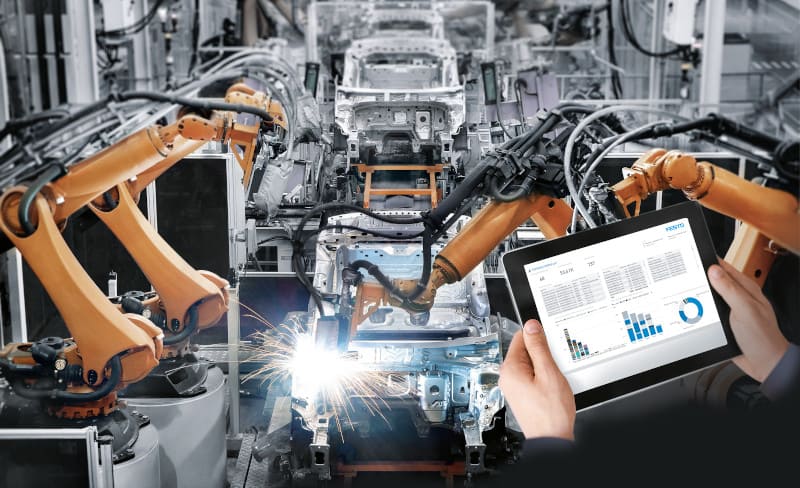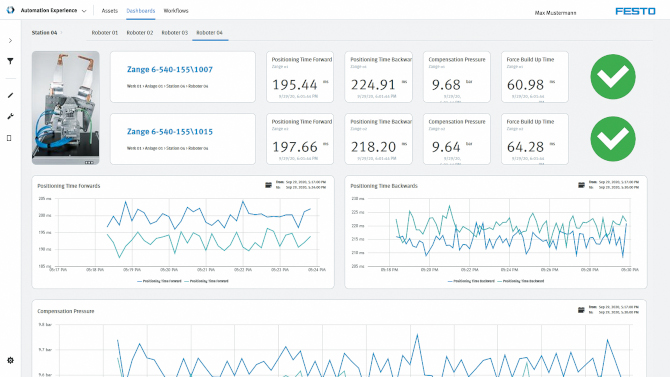A leading car manufacturer has been relying on the pinpoint accuracy and efficiency of servo-pneumatic welding guns from Festo for many years. So much so that they have now installed more than 2,500 welding gun robots with this technology in the premium brand’s body shops. This car manufacturer has now been able to reduce downtimes by 25 percent thanks to a predictive maintenance system from Festo which is ready for artificial intelligence.
Festo puts into practice in car factories what other automation companies only talk about. It implements projects in numerous applications in the automotive and Tier 1 supplier industry, metalworking as well as in the food industry where predictive maintenance – in the future with artificial intelligence – ensures that process deviations are detected in good time, maintenance is optimised and energy is saved.
Generating added-value solutions
At the same time, customer-specific solutions together with application knowledge enable agile, innovative approaches. The experience gained then provides the potential to replicate these solutions in the standard business. The challenge is to use the data from the devices and from the application environment with the knowledge of the processes to deliver real added value for the end customer.
The benefits are obvious. Car manufacturers can schedule repairs to welding guns during non-productive times and thus increase the availability of their plants. The status of the welding gun can be modelled in the control system. Automated repair orders and even “life cycles” for welding guns are thus easy to generate. Filter functions enable comparisons to be made. The early detection of leaks results in energy savings, since energy and maintenance costs play such a major role in the body shop.
Predictive maintenance
Nowadays mechatronic system products from Festo for resistance spot welding already process a lot of data and compress it so that it can be used as diagnostics for maintenance. But simply providing and displaying data is not enough. In future, predictive maintenance on the basis of artificial intelligence will offer additional possibilities in comparison with traditional condition monitoring approaches. Data from the devices will be merged with process data and evaluated using analytics models and cloud-based solutions.
The system specialists at Festo have added software to the existing system PCs of the robot cell that collects the welding gun’s diagnostic data and sends it to a collection point in the cloud. Running in the cloud is a maintenance application that, as well as visualising the data in the browser (maintenance dashboards), also evaluates it with respect to the expected service life.
The challenge of data transfer
“The first challenge here was to transfer the welding gun’s data from production to the cloud. Topics like network traffic, processor loads and data security were uncharted territory for both parties at that time,” explains Dr Jan Bredau, Head of Application Software for System Solutions at Festo.
The hardware concept of the servo-pneumatic welding gun was developed by Festo in close cooperation with experts from the automotive industry. This enabled Festo’s product developers to take many of the features required by the industry into consideration, including the reduction of the envelope because the servo-pneumatic system is considerably more compact than comparable welding actuators. Users can now install and operate the electronic and pneumatic sections of the control system either as a single unit or separately, in line with their requirements and the application. This makes the system significantly more flexible and leads to the various concepts for mounting on robots.
If linked to the factory maintenance system, “predictive” maintenance orders are triggered in their usual environment and, if desired, sent by SMS to the maintenance technician’s mobile phone.
“Now what belongs together will grow together: we have decades of application knowledge in sensors and actuators that we can now combine with domain and data science knowledge. This will open the door for artificial intelligence in the application,” concludes Bredau.


